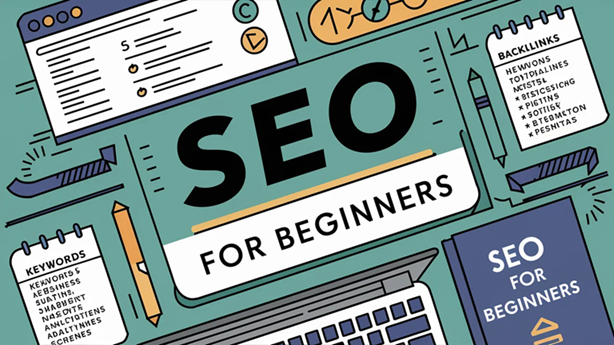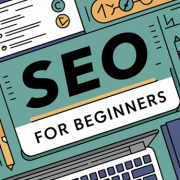Standing out is challenging in the bustling world of the internet. How do some websites appear at the top of search results while others are buried on the tenth page? The answer lies in Search Engine Optimization or SEO. If you’re new to SEO and want to learn how to make your website more visible and attract more visitors, this guide is for you. We’ll cover everything about SEO for beginners to get started with SEO in a simple, easy-to-understand way. For the latest practices explore the best SEO practices 2024 to ensure your website not only ranks higher but also engages and retains visitors effectively.
What is SEO?
SEO, or Search Engine Optimization, is the process of improving your website so that it ranks higher in search engine results. When someone searches for something on Google, Bing, or any other search engine, they usually click on one of the first few results. SEO helps your website become one of those top results, which means more people will visit your site.
Why is SEO Important?
SEO is crucial for several reasons:
- Increased Visibility: The higher your website ranks, the more likely people are to see it.
- More Traffic: Higher visibility means more visitors to your site.
- Credibility and Trust: Websites that appear at the top are often seen as more trustworthy.
- Cost-Effective: Unlike paid ads, organic traffic (visitors who come to your site through search engines) doesn’t cost you anything.
- Better User Experience: Good SEO practices also improve the overall experience for your visitors.
How Do Search Engines Work?
Before diving into SEO strategies(SEO for Beginners), it’s essential to understand how search engines like Google work. Search engines have three primary functions:
- Crawling: Search engines use bots (also called spiders or crawlers) to discover content on the web.
- Indexing: Once they find content, they store it in a massive database called the index.
- Ranking: When you search for something, search engines sort through the index and display the most relevant results.
Basic SEO Concepts
To get started with SEO, you need to understand some basic concepts:
Keywords
Keywords are the words or phrases people use to search for something online. For example, if someone wants to buy shoes, they might type “buy shoes online” into a search engine. Identifying and using the right keywords is crucial for SEO.
On-Page SEO
On-page SEO involves optimizing individual pages on your website to rank higher and earn more relevant traffic. It includes:
- Title Tags: The title of your page that appears in search results.
- Meta Descriptions: A brief description of your page that appears in search results.
- Headings: Using headings (like H1, H2, and H3) to organize your content.
- Content: Creating high-quality, relevant content that includes your keywords.
- URL Structure: Making sure your URLs are simple and include keywords.
- Images: Using alt text to describe images so search engines can understand them.
Off-Page SEO
Off-page SEO involves activities outside your website that can improve your rankings. This includes:
- Backlinks: Getting other websites to link to your site.
- Social Media: Promoting your content on social media platforms.
- Guest Blogging: Writing articles for other websites with links back to your site.
Technical SEO
Technical SEO focuses on improving the technical aspects of your website to help search engines crawl and index your content more effectively. It includes:
- Site Speed: Ensuring your website loads quickly.
- Mobile-Friendliness: Making sure your site works well on mobile devices.
- Sitemap: Creating a sitemap to help search engines find all your pages.
- Robots.txt: A file that tells search engines which pages they can or cannot crawl.
SEO for Beginners: Step-by-Step Guide
Now that you know the basics, let’s dive into a step-by-step guide to get you started with SEO.
Step 1: Keyword Research
The first step in any SEO strategy is keyword research. Here’s how to do it:
- Brainstorm: Think about what words or phrases your target audience might use to find your products or services.
- Use Tools: Use keyword research tools like Google Keyword Planner, Ahrefs, or SEMrush to find popular keywords related to your business.
- Analyze Competitors: Look at the keywords your competitors are using to get ideas.
- Choose Keywords: Select a mix of short-tail keywords (e.g., “shoes”) and long-tail keywords (e.g., “buy running shoes online”).
Step 2: Optimize Your Website
Once you have your keywords, it’s time to optimize your website.
Title Tags and Meta Descriptions
- Title Tags: Include your primary keyword and keep it under 60 characters.
- Meta Descriptions: Write a compelling description under 160 characters that includes your keyword.
Headings
- Use H1 for the main title, and H2 or H3 for subheadings.
- Include keywords in your headings naturally.
Content
- Create high-quality, original content that provides value to your visitors.
- Use your keywords naturally throughout the content.
- Include images, videos, and infographics to make your content more engaging.
URL Structure
- Keep URLs short and include your keywords.
- Use hyphens to separate words (e.g., yoursite.com/buy-running-shoes).
Images
- Use high-quality images.
- Add alt text that describes the image and includes your keyword.
Step 3: Improve Technical SEO
Ensuring your website is technically sound is crucial for SEO.
Site Speed
- Compress images to reduce their size.
- Use a content delivery network (CDN) to speed up your site.
- Minimize code (CSS, JavaScript) to improve loading times.
Mobile-Friendliness
- Use a responsive design that adjusts to different screen sizes.
- Test your site on various devices to ensure it looks good and works well.
Sitemap
- Create a sitemap.xml file that lists all your pages.
- Submit your sitemap to Google Search Console.
Robots.txt
- Create a robots.txt file to control which pages search engines can crawl.
- Use it to block pages you don’t want to appear in search results, like admin pages.
Step 4: Build Backlinks
Backlinks are links from other websites to your site. They are essential for SEO because they show search engines that your site is trustworthy and authoritative.
How to Get Backlinks
- Create High-Quality Content: Content that is informative and valuable is more likely to be shared and linked to.
- Guest Blogging: Write articles for other websites with links back to your site.
- Reach Out: Contact website owners and ask them to link to your content.
- Social Media: Share your content on social media to increase visibility and the chances of getting backlinks.
Step 5: Monitor and Improve
SEO is not a one-time task but an ongoing process. Here’s how to keep improving:
Use Analytics
- Google Analytics: Track your website’s traffic, bounce rate, and user behavior.
- Google Search Console: Monitor your site’s performance in search results, check for errors, and see which keywords are driving traffic.
Regular Updates
- Content: Update your content regularly to keep it fresh and relevant.
- Keywords: Revisit your keyword strategy periodically to ensure you’re targeting the right terms.
- Technical SEO: Keep an eye on your site’s technical health and fix any issues promptly.
Common SEO Mistakes to Avoid
Even with the best intentions, it’s easy to make mistakes when starting with SEO. Here are some common pitfalls to watch out for:
Keyword Stuffing
Keyword stuffing is the practice of overloading your content with keywords in an attempt to rank higher. This can lead to a poor user experience and can be penalized by search engines. Instead, use keywords naturally and focus on providing value to your readers.
Ignoring Mobile Users
With more people using mobile devices to browse the internet, having a mobile-friendly site is crucial. Ensure your website looks good and functions well on smartphones and tablets.
Forgetting About User Experience
SEO is not just about pleasing search engines; it’s also about creating a positive experience for your users. Make sure your website is easy to navigate, loads quickly, and provides valuable content.
Not Using Analytics
Without analytics, you won’t know if your SEO efforts are paying off. Regularly check your website’s performance and make data-driven decisions to improve your strategy.
Neglecting Local SEO
If you have a local business, local SEO is essential. Make sure your business is listed on Google My Business, and encourage customers to leave reviews.
Also Read: Ecommerce Fashion Content Marketing Strategies
Conclusion
Starting with SEO can seem overwhelming, but by following the steps outlined in this guide of SEO for beginners, you can begin to improve your website’s visibility and attract more visitors. Remember, SEO is a long-term investment that requires ongoing effort and attention. By understanding the basics, avoiding common mistakes, and continually refining your strategy, you can set your business up for online success.
So, roll up your sleeves and get started with SEO today. With patience and persistence, you’ll see your website climb the search engine rankings and enjoy the benefits of increased traffic and visibility.











Comments